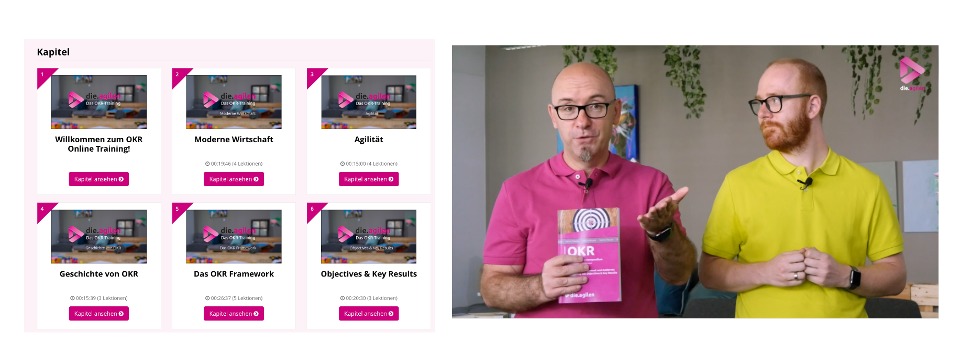COVID-19 forces us all to work from home and moves us to do many of the usual activities online. From visits to the authorities to shopping and continuing education, new opportunities are booming on the Internet. Vocational training, which is currently not taking place or hardly taking place in the form of face-to-face courses, is particularly affected. Especially in times of job insecurity due to a possible economic crisis, you should keep yourself particularly fit and develop new skills.
A good alternative to face-to-face courses is video training that takes place online. The company: die.agilen gave me a taste of a video training session and I would like to try it out for you. At the end of the article, I’ll give you a summary of the training and the general suitability of video training for professional development.
I have to admit that I was also very classy in this area and read a few books for my professional development and attended my 2-3 face-to-face training sessions a year. That’s why I’m particularly excited about the video training.
Video training on OKR
In the following I would like to give my impression of the video training. To do this, I first show some general data, then go into general use and at the end on the content of the training.
General
The training revolves around Objectives & Key Results (OKR) and was designed from more than 9 years of practical experience in more than 500 companies and through the training of more than 4,500 certified OKR masters. The video is divided into 37 lessons and takes just under 3h 30min. It can be played in almost any browser and the lessons are between 10 and 30 minutes long. The training costs 159 euros net.
Look and feel
The training is clearly presented in lessons with 2-6 videos each. In each video, a separate topic is covered briefly and to the point with many examples. I watched the training spread across the board. Some lessons in the evenings after work or on the weekend and a few others on the side on the treadmill in the gym or in the subway. It always worked out well to work out a small part of the material piece by piece.
The progress bar always showed me which chapter I was in and where I could continue learning. Depending on how important the lessons were for me, I watched them between one and three times. While you can ask questions in face-to-face training, the advantage here is that you can watch videos repeatedly.

Content
In general, OKR is a management framework for collaboration. The two coaches include the following dimensions in the OKR framework:
- Critical thinking
- discipline
- collaboration
- Focus of effort
- Create measurable contributions
- Moving the company forward
Generally speaking, OKR means Objective and Key Results. An objective is a precise statement about a comprehensive qualitative goal that the organization tries to drive in a desired direction. It is usually derived from the company’s mission statement.
As the English term suggests, a key result is a key result of the objective. Each objective can have any number of key results. The coaches recommend measuring such a key result according to the well-known smart criteria and even add a few “A” to “SMAAART”:
- Specific
- Measurable
- Accepted
- Ambitious
- Derived from the objective
- Realistic
- Terminated
But how can the OKR framework be implemented sensibly? The two coaches recommend the following in the training:
The first step is to derive objectives from the company’s mission statement. The coaches also recommend setting so-called mid-term goals MOKRS. The training says: A clear mission and aligned OKR – whether monthly, quarterly or annually – help to ensure that the work done in the short time fits the long-term purpose and goal of the company. The coaches suggest a period of 6-12 months for this.
A fixed cycle now follows, which regularly checks compliance with the objectives by checking the key results. A so-called OKR master should monitor this. The OKR Master has 5 roles: coach, facilitator, expert, process monitor and change agent. He is responsible for the process and therefore its owner. Its mission is to make sure the company has continued success with OKR.
The control loop consists of OKR planning, OKR weekly, retrospectives and reviews. All of this is monitored and moderated by an OKR master. Of course, I could only briefly touch on a fraction of the training in this text. There are still many examples and explanations for organizational development and agility. For a deeper insight, it is worth taking a look at the training on the die.agilen website.

Conclusion
In times of Corona, further education is still the be-all and end-all. But especially in stressful times, it is impossible to deal with a topic for days without being disturbed or to attend full-day classroom training due to the pandemic. One solution for this is video training, which offers short and concise lessons.
I tried such a training with the video training on OKR from die.agilen. Especially the short lessons with progress bar make it easy for me to watch 1-3 short videos every day on the way to work or even in the gym. The short video units in particular make it possible to watch the training piece by piece. I believe that video training is a great alternative and that it will certainly move more and more into the focus of professionals.
The content of the training was well prepared and followed a clear line: Theoretical constructs underpinned with practical examples. I particularly liked the excursions into organizational development. It is important for me to understand: Why are we currently doing what we are doing, why do we want to change it and, above all, where are we going?
The training was moderated by two friendly trainers who put a lot of effort into the training. I would like to thank you very much for the opportunity that I was allowed to watch this. If you also feel like training, you can find the descriptive OKR training on the die.agilen website, for example.
Image source: Screenshots from die.agilen
[fotolia]


